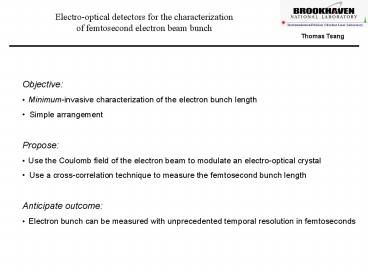Electrooptical detectors for the characterization - PowerPoint PPT Presentation
1 / 9
Title:
Electrooptical detectors for the characterization
Description:
chirped probe pulse. Coulomb field encoded on part of the spectrum through Pockels effect ... single-shot cross/auto-autocorrelations are sensitive to spatial chirp ... – PowerPoint PPT presentation
Number of Views:42
Avg rating:3.0/5.0
Title: Electrooptical detectors for the characterization
1
Electro-optical detectors for the
characterization of femtosecond electron beam
bunch
Thomas Tsang
- Objective
- Minimum-invasive characterization of the
electron bunch length - Simple arrangement
- Propose
- Use the Coulomb field of the electron beam to
modulate an electro-optical crystal - Use a cross-correlation technique to measure
the femtosecond bunch length - Anticipate outcome
- Electron bunch can be measured with
unprecedented temporal resolution in femtoseconds
2
Techniques for electron beam bunch length
measurements
- Coherent transition radiation Invasive, needs to
collect all radiated THz frequencies,
measurement of the THz beam field also relies on
EO technique - Repetitive EO sampling with short light pulses
highest temporal resolution, not single-shot, no
real-time diagnostic - Single-shot EO sampling with short light pulse
good temporal resolution, real-time, single-shot,
minimum invasive
3
In order to measure a short event in time, you
need a shorter one.
To study this event, you need a strobe light
pulse that is shorter.
Photograph taken by Harold Edgerton, MIT
But then, to measure the strobe light pulse, you
need a detector whose response time is even
shorter!!
Rick Trebino
So, how do we measure the shortest electron
pulse?
Borrow the well known ultrashort optical pulse
measurement techniques
- Spectral encoding
- the strength of the electron beam field is
encoded on an EO crystal
- Auto- or cross-correlation
- nonlinear frequency conversion crystal is
needed
- FROG or SPIDER
- more complications?
4
EO modulation - spectral encoding technique
- chirped probe pulse
- Coulomb field encoded on part of the spectrum
through Pockels effect - cross analyze and recover the polarization
modulated spectral intensity
Coulomb field
e- bunch
Electron beam THz field
EO crystal
Chirped probe pulse
fs
tc
to unchirped pulse duration
Wilke, et. al. PRL 88, 124801 (2002)
- single-shot, sub-picosecond resolution
- spectral encoding technique has a fundamental
time resolution limit, tmin vto tc -
e.g.1 to 30 fs, tc 20 ps, tmin
770 fs -
e.g.2 to 4 fs, tc 3 ps,
tmin 110 fs -
e.g.3 to 20 fs, tc 5 ps,
tmin 316 fs - ?telectron?100 -10 fs, electron bunch length is
lengthed and distorted
5
Why is there a fundamental time resolution limit,
tmin vto tc ?
Quantitative (somewhat)
Fletcher, Optics Express 10, 1425, (2002), Zhang
et.al., QE 36, 1214 (2000).
e- beam
chirped light pulse
EO modulated temporal profile
spectrometer measure
for strong modulation
where
for weak modulation
Telectron gt Tmin
Telectron lt Tmin
- ?telectron?100-10 fs
- bunch length is distorted THz field ? optical
carrier spectrum ? additional spectral
modifications
6
Why is there a fundamental time resolution limit,
tmin vto tc ?
Qualitative
In order to measure a short event in time, you
need a shorter one.
is violated
spectral intensity alone does not yield true
bunch length information
7
The relative importance of spectral intensity and
phase
Rick Trebino
His wife Linda
Composite photograph made using the spectral
intensity of Lindas photo and the spectral phase
of Rick (and inverse-Fourier-transforming)
Composite photograph made using the spectral
intensity of Rick and the spectral phase of
Lindas (and inverse-Fourier-transforming)
The spectral phase is more important for
determining the intensity!
Rick Trebino
8
Cross correlation technique
1.
Coulomb field
e- bunch
- Spectral encoding on chirped pulse
- SHG single-shot cross correlation
- Temporal to spatial transformation
Electron beam THz field
EO crystal
Chirped probe pulse
fs
fs
tc
unchirped probe pulse
to
3.
CCD
2.
Cross-correlated beam
Second-harmonic generation crystal
- single-shot, minimum invasive, femtosecond
resolution - envelope of the spectral phase is recovered
- no timing ambiguity
- weak EO modulated signal can be amplified by
increasing the intensity of the unchirped probe
pulse - the entire bandwidth of the short probe pulse is
used to measure an equally short electron bunch
In order to measure a short event in time, you
need a shorter one.
is NOT violated
Jamison, et. al., Optics Letters 28, 1710 (2003).
9
Other considerations
- single-shot cross/auto-autocorrelations are
sensitive to spatial chirp - the shorter the e- bunch, a larger THz
bandwidth is required on the EO crystals - thinner EO and SHG crystals ? smaller
signal photons. - XFROG/SPIDER
Conclusions
- to proceed to femtosecond temporal
characterization, - optical pulses shorter than the electron
bunch are needed spectral encoding - to characterize a femtosecond electron bunch
length w/o a timing ambiguity, - it is necessary to cross-correlate the
spectrally encoded EO signal pulse - with an unchirped pulse to recover the
Coulomb field envelope information - to fully characterize the encoded spectrum
modulated by the Coulomb beam field, - XFROG/SPIDER might be necessary.































